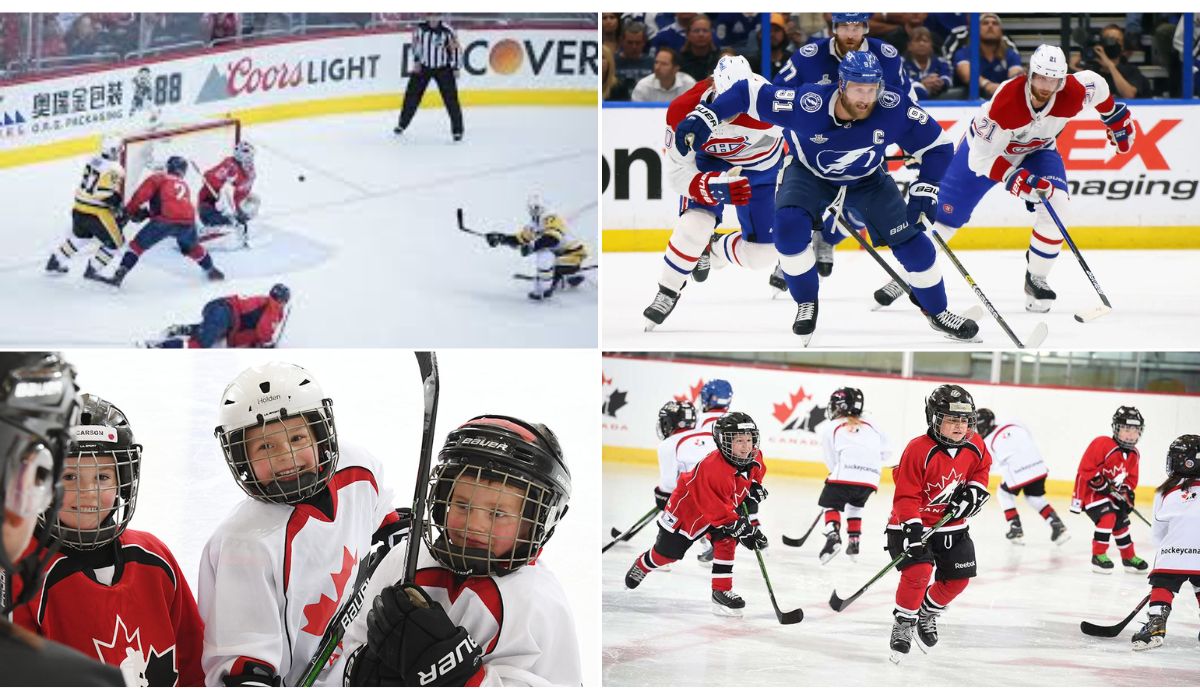Introduction to Hockey and Player Pathways
Hockey isn’t just a sport—it’s a way of life in many parts of the world, especially in North America, where the game holds a special place in communities. From frozen ponds in Canada to packed college arenas in the U.S., hockey continues to grow globally, with strong programs in countries like Russia, Sweden, and Finland.
For young athletes, hockey offers several development pathways. At the college level, players typically choose between Club Hockey, governed by organizations like the ACHA, or National Hockey under the NCAA. Each path serves a different purpose: Club Hockey allows players to balance academics with a love for the game, while NCAA Hockey offers elite competition and professional development opportunities.
Having experienced the competitive hockey environment firsthand, I understand the importance of choosing the right path. This guide will help break down the key differences, giving players and families the information they need to make the best decision.
What is Club Hockey?
Club hockey offers college students an opportunity to continue playing competitive hockey outside the NCAA structure. It’s governed by organizations like the American Collegiate Hockey Association (ACHA) and Collegiate Hockey Federation (CHF). These leagues organize regular seasons, playoffs, and even national championships, providing a serious but flexible environment for athletes who want to stay on the ice without the full-time commitment of varsity athletics.
Levels of Club Hockey
There are three levels in the ACHA: D1, D2, and D3. ACHA D1 teams are highly competitive, often featuring former junior and high-level players. D2 offers a balanced competition level, ideal for those juggling academics and hockey. D3 provides a relaxed, recreational experience while still maintaining a team structure. Many ACHA D1 teams can rival NCAA DIII programs in skill and intensity.
Who Plays Club Hockey?
Club hockey draws a wide range of players—graduate students, former CHL players, and recreational athletes. It’s perfect for those who want to keep playing competitively without the rigid NCAA commitment. Players often join for love of the game and the unique team bond, making it a great fit for those seeking both fun and serious competition.
What is National (NCAA) Hockey?
NCAA hockey is collegiate-level ice hockey organized by the National Collegiate Athletic Association (NCAA) and divided into Division I (DI), Division II (DII), and Division III (DIII). DI offers the highest level of competition, featuring elite athletes and top-tier programs with strong athletic funding. DII is less common but competitive, while DIII focuses on balancing academics and athletics, providing fewer athletic scholarships but fostering a love for the game.
Competitive Level and Recruitment Process
The level of competition in NCAA hockey is intense, especially in DI, where many players are recruited from top junior leagues like the USHL or CHL. Recruitment is highly selective, with coaches scouting at major tournaments. Athletes who excel in NCAA hockey often pursue professional careers in the NHL, AHL, or top European leagues.
Who Plays NCAA Hockey?
NCAA hockey attracts serious athletes who aim to play professionally, but it’s also ideal for those who want to continue competing while earning a degree. Players gain more than just on-ice experience—they develop leadership, discipline, and time management skills that benefit them long after graduation. Many former NCAA athletes thrive in careers both within and outside of hockey.
Key Differences Between Club Hockey and National Hockey
Competitive Level
NCAA hockey is highly competitive, with top-tier players aiming for professional careers. Teams are well-structured, and the competition is fierce. Club hockey, however, accommodates a broader range of skill levels, making it more inclusive. While some club teams are competitive, the overall environment is more relaxed.
Time Commitment
NCAA hockey demands a significant time investment, with daily practices, games, and travel. Balancing academics can be tough. Club hockey, on the other hand, offers flexibility, allowing athletes to manage academics and personal life while still competing.
Cost and Scholarships
NCAA players may receive scholarships, easing the financial burden of tuition. Club hockey is self-funded, with players covering expenses like equipment and travel. Despite the costs, many choose club hockey for its balance of competition and enjoyment.
Player Development and Exposure
NCAA hockey provides excellent exposure to pro scouts and top leagues, making it ideal for those pursuing a professional career. Club hockey emphasizes enjoyment and personal development, with less focus on professional advancement.
Eligibility Rules
NCAA enforces strict eligibility and age rules, while club hockey offers more flexibility, allowing players, including graduate students, to compete. This makes club hockey accessible for those who want to continue playing beyond traditional college years.
Similarities Between Club and National Hockey

Both club and national hockey provide athletes with the chance to play competitively, offering organized leagues and regular practices. Whether on an NCAA team or a club squad, players gain structure, coaching, and the opportunity to stay sharp. From my experience, the commitment required at both levels keeps athletes engaged, whether aiming for the pros or simply enjoying college hockey.
Both formats also feature regional tournaments and national championships, adding excitement and a larger goal to work toward. These competitions create intense rivalries and memorable moments, whether you’re on a national or club team, with opportunities to showcase your skills on a big stage.
Additionally, both paths emphasize team spirit, leadership, and sportsmanship. Players learn to work together, respect opponents, and lead when needed. Hockey teaches life skills, making both club and national hockey about more than just the game—it’s about personal growth and teamwork.
Pros and Cons of Club Hockey
Pros
Flexibility is a major advantage of club hockey. Players can balance their sport with academics, work, or other commitments since club teams typically have less demanding schedules. It’s a great way to stay involved in hockey without the pressure of NCAA schedules. Additionally, lower pressure and time commitment make it a fun, less stressful option for those who want to enjoy the sport without sacrificing everything else in their life. Club hockey also provides an inclusive environment where players of all skill levels can participate, making it a welcoming place for both newcomers and experienced athletes alike.
Cons
However, club hockey can be less competitive compared to NCAA programs, which means the level of play may not be as high. This can be disappointing for those seeking a more intense hockey experience. Self-funding is another downside—players often have to cover their own expenses for equipment, travel, and fees, unlike NCAA athletes who may receive financial support. Lastly, lower professional exposure limits opportunities for players who aspire to make it to the NHL or other major leagues. While club hockey keeps the sport enjoyable, the pathway to professional hockey isn’t as clear.
Pros of National (NCAA) Hockey
High-Level Competition: NCAA hockey features some of the best players from around the world. With top athletes from junior leagues like the CHL and USHL, players face intense competition, helping them develop skills that elevate their game to a professional level.
Player Development Opportunities: NCAA teams offer excellent coaching, facilities, and training, helping athletes improve their technical skills and hockey IQ. The exposure to scouts and national tournaments provides players with the opportunity to go professional.
Scholarships and Financial Support: Many NCAA schools offer athletic scholarships, covering tuition, room, and board. This financial support eases the burden of college expenses, allowing athletes to focus on academics and hockey.
Cons of National (NCAA) Hockey
Time Commitment and Pressure: NCAA hockey demands a lot of time with intense practice schedules, games, and travel, often leading to high levels of stress. Balancing academics and sports can be overwhelming for many athletes.
Strict Eligibility Rules: NCAA has strict regulations regarding age, amateur status, and recruitment, limiting options for some players. These rules can restrict eligibility for athletes with professional experience or certain backgrounds.
Lack of Flexibility: The demanding schedule leaves little time for extracurricular activities or personal interests. NCAA players often have to prioritize hockey, limiting their ability to explore other aspects of college life.
8. Which Pathway is Best for You?
Factors to Consider When Choosing Between Club and National Hockey
Skill Level and Aspirations
If you aim to play at the highest level and pursue a professional career, NCAA hockey is the right choice. NCAA teams are highly competitive and attract professional scouts. If your goal is more about enjoying the game and improving your skills without the pressure, club hockey offers a more relaxed environment.
Time Commitment and Academics
NCAA hockey demands a significant time investment, making it difficult to balance with academics. If you prefer more flexibility, club hockey allows you to juggle your sport with other priorities, including school or personal interests.
Financial Considerations
NCAA hockey may offer scholarships, but they are highly competitive. Club hockey generally involves fewer financial burdens but requires players to pay their own way, making it a more affordable option for some.
Who Should Choose Club Hockey?
Club hockey is ideal for those who want to continue playing the sport while balancing other commitments like academics or personal life. It’s also great for players who aren’t seeking a professional career but want to stay active and enjoy the game.
Who Should Choose National Hockey?
If your dream is to go pro or play at a high level, NCAA hockey is the best choice. It offers greater exposure and development opportunities, making it ideal for players dedicated to pursuing a professional career.
Conclusion:
In conclusion, the decision between club hockey and national hockey depends largely on your personal goals, level of commitment, and aspirations. If you’re aiming for a professional career and want the highest level of competition, national hockey offers the structured pathway and exposure needed to reach your goals. On the other hand, club hockey provides a more flexible and enjoyable experience, perfect for players who want to continue enjoying the sport without the intense pressure of NCAA commitments. Ultimately, whether club hockey or national hockey is better for you comes down to what you value most in your hockey journey—competition, time commitment, or personal balance.
FAQ: Hockey Questions Answered
What are the levels of hockey in order?
- Youth Hockey
- High School Hockey
- Junior Hockey
- College Hockey (NCAA D1, D2, D3, ACHA)
- Professional Hockey (NHL, AHL, ECHL, European Leagues)
Which hockey is more popular?
Ice hockey is more popular globally, especially in North America, with field hockey being more popular in regions like Europe and Asia.
Which country has the best hockey?
Canada is considered the best in hockey, with the most top-tier players, followed by the U.S., Russia, Sweden, and Finland.
What level is ACHA hockey?
ACHA is a club-level college hockey league, with Division I being the highest, sitting below NCAA hockey.
For more Please visit : Bigsportsgames


